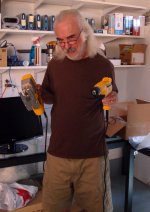I would like to have some views over Nelson's shoulder. Then I would feel to live in heaven, not only Himalaya....
Can someone, perhaps Papa, explain the SE bias in the XA30.5 amplifier. As I understand it, the XA30.5 has 5 active mosfets per quadrant and somewhere around -60ma SE bias using 5 parallel 2.2K resistors to the -rail. Assuming that everything is balanced, as suggested by the Stereophile Review, and the 2nd harmonic is cancelled, what is the purpose of the SE bias? Could it be to help balance the transconductances of the N-FETs vs. the P-FETs?
If the X.5 series amplifiers where Class-B, I would understand the use of SE bias to shift the crossover point away from zero volts.
If the X.5 series amplifiers where Class-B, I would understand the use of SE bias to shift the crossover point away from zero volts.
Could it be to help balance the transconductances of the N-FETs vs. the P-FETs?
Very good approach, but if this were true it could only be a rough approximation for balanced transconductances.
AFAIK Nelson combined several identical output boards in his different amp models, therefore current through these resistors varied with supplies.
Besides this I have seen schematics where value of these resistors was 3k3 and not 2k2.
Very good approach, but if this were true it could only be a rough approximation for balanced transconductances.
AFAIK Nelson combined several identical output boards in his different amp models, therefore current through these resistors varied with supplies.
Besides this I have seen schematics where value of these resistors was 3k3 and not 2k2.
...
AFAIK Nelson combined several identical output boards in his different amp models, therefore current through these resistors varied with supplies.
Besides this I have seen schematics where value of these resistors was 3k3 and not 2k2.
The higher 3k3 resistances would be consistent with rail voltages 1.5x higher. Quite possible.
Voltage differences between smallest and largest XA.5-models had a factor of 1,32.
I assume that Nelson changed to 2k2-resistors simply to get higher SE-bias.
In new XA.8-models I believe that he increased this SE-bias. This would be logical because he now uses one pair of output devices (per quadrant) for SE-purposes.
If this were correct it would contradict your balanced-transconductance-theory.
I assume that Nelson changed to 2k2-resistors simply to get higher SE-bias.
In new XA.8-models I believe that he increased this SE-bias. This would be logical because he now uses one pair of output devices (per quadrant) for SE-purposes.
If this were correct it would contradict your balanced-transconductance-theory.
Voltage differences between smallest and largest XA.5-models had a factor of 1,32.
I assume that Nelson changed to 2k2-resistors simply to get higher SE-bias.
In new XA.8-models I believe that he increased this SE-bias. This would be logical because he now uses one pair of output devices (per quadrant) for SE-purposes.
If this were correct it would contradict your balanced-transconductance-theory.
I am thinking that the SE-bias has a rather differnt role in the XA.8 series. If the XA.8 series SE-bias is asymmetric in order to generate (or preserve) 2nd order harmonics (H2), then the level of the bias affects the amount of H2.
Asymmetry in CCS for SE probably helps to shape 2nd harmonics (in excess of k3) at low power levels.
Level of bias of course must affect k2 for higher power levels.
Level of bias of course must affect k2 for higher power levels.
This would be logical because he now uses one pair of output devices (per quadrant) for SE-purposes.
Was that a typo of did I totally miss something? Based on the 6Moons photos, I thought that only one device was used per phase, on opposite rails in each phase, for SE-purposes.
sez he ........ right before adding :
"and now I'm going to chop ya ...... "

....aha!!! insider info....are those hard drives on the shelves with all the FXXs to come ?
😀😀
What i like most ...apart from the fantastic music nelsons amps give us , is the fact that we can learn so much from him....having fun is really what it's all about.
...and a bottle of red 'course ...i am portuguese after all.
😀😀
Was that a typo of did I totally miss something? Based on the 6Moons photos, I thought that only one device was used per phase, on opposite rails in each phase, for SE-purposes.
Thank you for pointing out my error.
When writing this I thought about both channels, may be also because XA-amps are mainly monaural amps.
Sorry, I did not want to mislead anybody.
On the face of it, I would have expected that you could, and I have played
with several approaches which manipulate the harmonic character in the
front end, but none of them subjectively duplicate having that character in
the output stage itself.
I don't have a good answer why, but I believe it relates to the manner in
which the output stage interacts with a complex load.
😎
Does that mean that the output of the front-end after feedback should have a very "neutral" harmonic character, such as nulled H2? What about the harmonic character of each phase?
Sorry to have neglected this thread, having been busy with the VFET pt 2,
but to address some of the questions:
As I pointed out in "Leaving Class A", the benefits of single-ended bias are
varied depending on the application.
First off, it tends to stabilize the bias in push-pull amplifiers because it
reduces the drift. It also tends to reduce distortion in general.
In the case of single (unbalanced) output amplifiers, the amount and phase
of the single-ended bias lets you null intrinsic 2nd harmonic in the amplifier
or set it at an arbitrary value and phase. Personally, I tend toward the
"Hiraga" values, where at lower power levels we want the 2nd to be a
greater proportion than third and so on, but I will point out that this is not
always the best sound for any given amplifier. And of course there are
numerous different tastes to be satisfied.
In the case where it is applied to balanced circuits you can pretty much do
the same thing - it's just another tool in the box.
I have played with this phenomenon in front end circuits - sometimes it
works and sometimes it doesn't. I have noticed that playing with these
things is usually more effective if you do it in the output stage itself, and
there are two likely reasons:
1) The output stage is talking to the loudspeaker and the complex
impedance there could easily be involved.
2) The output stage is generally the biggest offender with regards to
distortion, and so adjustments there go closer to the source of the
problem.
As DIYers, the main thing is not to just imitate my settings and such,
rather you want to take it upon yourselves to experiment and see what
you get. All the tools are pretty much on the table, and applying them is
straightforward.
but to address some of the questions:
As I pointed out in "Leaving Class A", the benefits of single-ended bias are
varied depending on the application.
First off, it tends to stabilize the bias in push-pull amplifiers because it
reduces the drift. It also tends to reduce distortion in general.
In the case of single (unbalanced) output amplifiers, the amount and phase
of the single-ended bias lets you null intrinsic 2nd harmonic in the amplifier
or set it at an arbitrary value and phase. Personally, I tend toward the
"Hiraga" values, where at lower power levels we want the 2nd to be a
greater proportion than third and so on, but I will point out that this is not
always the best sound for any given amplifier. And of course there are
numerous different tastes to be satisfied.
In the case where it is applied to balanced circuits you can pretty much do
the same thing - it's just another tool in the box.
I have played with this phenomenon in front end circuits - sometimes it
works and sometimes it doesn't. I have noticed that playing with these
things is usually more effective if you do it in the output stage itself, and
there are two likely reasons:
1) The output stage is talking to the loudspeaker and the complex
impedance there could easily be involved.
2) The output stage is generally the biggest offender with regards to
distortion, and so adjustments there go closer to the source of the
problem.
As DIYers, the main thing is not to just imitate my settings and such,
rather you want to take it upon yourselves to experiment and see what
you get. All the tools are pretty much on the table, and applying them is
straightforward.
I was delighted to see the Sony VFET pt. 2 article.Sorry to have neglected this thread, having been busy with the VFET pt 2,
but to address some of the questions:
...
First off, it tends to stabilize the bias in push-pull amplifiers because it
reduces the drift. It also tends to reduce distortion in general.
...
Stabilizes the drift? I will have to think about that for a while.
What about the ability to select different bias currents and hence transconductances of the N vs. P output devices?
My previous question had more to do with the interactions of global feedback and the H2/H3 character of the front-end (FE) and output stage (OS). One can make the FE neutral in the absence of global feedback, but with global feedback turned, trying to make the OS output look like the input signal, the H2 of the FE output will become the negative of H2 of the OS. Thus, only a small fraction of the H2 character of the H2 of the OS will remain. Maybe that is ok, particularly when the feedback factor is only about 10dB.
Stabilizes the drift? I will have to think about that for a while.
Assuming of course that the CCS doesn't drift...
- Status
- Not open for further replies.
- Home
- Amplifiers
- Pass Labs
- XA.8 single-ended current sources


